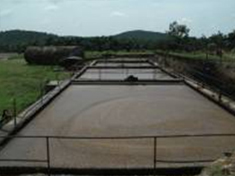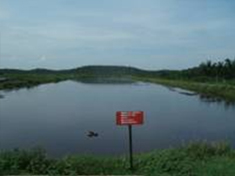Report
Overseas Field Training:The Waste and Energy Management in Malaysia Industry
 |
 |
|||
| Palm oil mill effluent | Anaerobic pond |
Place : Nam Bee Palm Oil Mill et al. in Malaysia
Date : 25 August – 4 September 2010
<Report by Shohei Riya>
Aim of the training
Malaysia has 40% of the palm oil share in the world. This great production of palm oil results in large consumption of energy and emission of waste. The aim of this training is to elucidate environmental and energy issues in Malaysian industry. We visited palm oil mill, sewage treatment plant and institutes for palm oil production and discussed with workers and researchers. Here, we summarized waste and energy usage in palm oil production.
Results
Palm oil mill is factory for palm oil production and emits solid waste (Empty Fresh Bunches (EFB)) and liquid waste (Palm Oil Mill Effluent (POME)) (Fig. 1). EFB is used as boiler fuel. POME contains much amount of organic matter and must be treated before discharge. Conventionally, POME has been treated by using anaerobic pond (Fig. 2). However, the pond treatment has caused emission of large amount of methane (CH4), which is a strong greenhouse gas. To overcome this problem, newly developed treatment system, Reversible Anaerobic Baffled Reactor (RABR) has been tested, which can treat POME with CH4 recovery. Recovered CH4 could be used as fuel for the trucks in the plantation near the palm oil mill. The effluent from the RABR can be used as a fertilizer in the plantation.
Discussion
The effluent contains ammonium (NH4+). It has been known that NH4+ is a precursor of the Nitrous Oxide (N2O) a 296 times stronger greenhouse gas than CO2. It brings an issue concern to emission of N2O by fertilization of the effluent. However, officers said N2O have not been measured in their plantation. If large N2O is emitted, this would be an offset of the reduction of CH4. In addition, usually the POME is also used as a fertilizer after the anaerobic pond treatment. Therefore, further research is needed for whether greenhouse gas emission is increased or not through the whole processes including POME treatment and fertilization.
Supervisor / Instructor and students traveled with :
Shin Taniguchi, Masaki Sagehashi, Long Zhao,